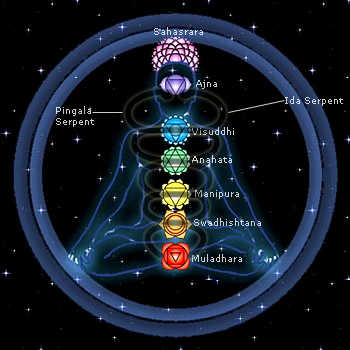 All the Yoga practice refers to Kundalini. The main aim of the Kundalini Yoga is the top of the head that is the brahmasthana, brahmarandhra, known as the hole-in-the skull, the nirvana chakra (circle where release is achieved) mahapatha (the great path of release). It is the place of final bliss (brahmananda). It is situated above the end of the susumna. The Kundalini Yoga makes large use of the major doctrine on the union of Lord Shiva and Shakti; that is, it swings around the idealisation of the experience of the ecstasy that arises in creative union. From the lowest centre (the muladhara) to the place of final bliss (in the sahasrara), each level, conceived of as place of enjoyment, is symbolically the station of a god and a goddess; and at each of the stages in her ascent, Shakti drinks the nectar of the crescent moon.
All the Yoga practice refers to Kundalini. The main aim of the Kundalini Yoga is the top of the head that is the brahmasthana, brahmarandhra, known as the hole-in-the skull, the nirvana chakra (circle where release is achieved) mahapatha (the great path of release). It is the place of final bliss (brahmananda). It is situated above the end of the susumna. The Kundalini Yoga makes large use of the major doctrine on the union of Lord Shiva and Shakti; that is, it swings around the idealisation of the experience of the ecstasy that arises in creative union. From the lowest centre (the muladhara) to the place of final bliss (in the sahasrara), each level, conceived of as place of enjoyment, is symbolically the station of a god and a goddess; and at each of the stages in her ascent, Shakti drinks the nectar of the crescent moon.
The discipline of the Kundalini Yoga in so far as it concerns the lifting of Kundalini from her place in the muladhara to the region of the bindu, the nectar of the moon, which lies in the hollow above the throat, is described as a series of manipulations of bodily functions, physical exercises and with accompanying mental concentrations. The disciplines of the Hatha Yoga enable the adept to reverse the process of nature, so as to detain the bindu in original receptacle, or to draw it back, along with rajas, after the actual union. In the terminology of the Hatha Yoga, the two elements whose union is sought are the sleeping, female serpent (Kundalini) resting with her head in the aperture of the male organ and the bindu lodged in the hollow of the throat. She drinks the nectar where she is, or is to be, drawn upwards (by means of pranayama and other disciplines) through this, the brahmadvara, to higher centres, finally to the seat of bindu. She may enjoy the nectar at any of the stations along the susumna although the aim is union in the highest place. But, in all cases she drinks the nectar of the moon.
The main aims and methods of Kundalini Yoga are as follows -
•Immobility of body and of mental processes by asana, mudra, bhanda and pranayama
•Retention of the breathe
•Retention of the bindu
•The ecstatic experiences of the union of rajas (Kundalini) and bindu (Shiva) at various levels in the body
•Supernormal powers
•Final release
And to these ends:
•Cleansing of the nadis and chakras
•Breathe control
•Asana, mudra and bhanda
•Miscellaneous practices
Prana is also bindu and jiva; and its relation to Kundalini is referred to its origin in the svadhisthana and in the mantra hamsa. The lifting of Kundalini involves the understanding of the various chakras; that is, knowledge of the peculiar kinds of experience referred to each of them. Kundalini enjoys Shiva in each chakra in her form peculiar to that lotus, and finally reaches the eternal One in the sahasra. In the ajna she is Shakti on the mental plane; in the sahasra, on the spiritual plane. From this high place she should be brought back to the Muladhara. Thus, it is very necessary, apparently, that the Yogis need to follow the whole course through, since short-cuts to the end are suggested.




















